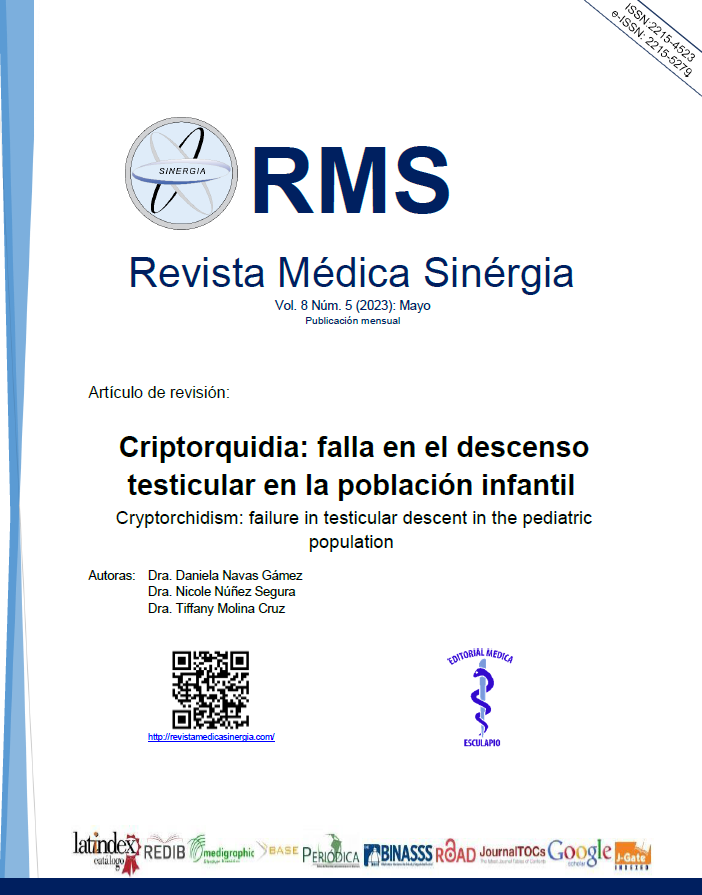Abstract
Cryptorchidism is described as the most recurrent malformation of the genitourinary tract in boys, which is defined as the lack or inadequate descent of the testicle into the scrotum, which occurs due to a problem in one of the stages of testicular descent. Two types of cryptorchidism have been detected, congenital and acquired, where in the last one recently mentioned the testicles seem to be in the scrotal sac during lactation, however during school age they ascend until they come out of the scrotal sac. Generally, this disease does not provide clinical manifestations, so diagnosing it early, early and adequate management will depend on how the test is predicted, the probability of cancer in the testicle and that it becomes malignant in adulthood. Orchidopexy occurs when the testis is fixed to the scrotal bag, and it will be the treatment of choice for cases of the testis that have not descended, since fixing the testis to the bag guarantees that it will not ascend again.
Keywords
References
Cebrián C, Liras J, Moreno C, Ayuso R. Patología testicular en la edad pediátrica: criptorquidia, escroto agudo y varicocele. Servicio de Cirugía Pediátrica. Complejo Asistencial Universitario de Salamanca. 2019; pag:1,10.
Arízaga SR, Vintimilla A, Lopez E, Cordero G, Córdova-Neira F. CRIPTORQUIDIA EN PEDIATRÍA. ATENEO [Internet]. 2018 [citado el 17 de febrero de 2023];20(2):161–9. Disponible en: https://colegiomedicosazuay.ec/ojs/index.php/ateneo/article/view/28
Atuan R, Gonzalez Y, Salcedo P, Vargova P, Bragagnini P, Ruiz M. Volumen testicular en pacientes adultos operados de criptorquidia en edad infantil y su efecto sobre la paternidad. Cir Pediatr. 2022; pag: 25,30.
Kolon T, Barthold J, Baker L, Baskin L, Baxter C, Cheng E, Diaz M, Herndon A, Lee P, Seashore C, Tasian G. Evaluación y tratamiento de la criptorquidia: guía de la AUA. American Urological Association Education and Research. 2019; pag: 1,61.
Grinspon R, Bedecarras PG, Gottlieb SE, Rey RA. Afectación de la función testicular en niños con criptorquidia. Rev Hosp Niños [Internet]. 2018 [citado el 17 de febrero de 2023];60:270; 10. Disponible en: https://ri.conicet.gov.ar/handle/11336/91261
Orquidopexia tardía en niños con criptorquidia y aumento del riesgo de cáncer testicular - [Internet]. Revista pediatrica HNRG. 2018 [citado el 17 de febrero de 2023]. Disponible en: http://revistapediatria.com.ar/volumen-60-edicion-270-primavera-2018/edicion-270-orquidopexia-tardia-ninos-criptorquidia-aumento-del-riesgo-cancer-testicular/
García M, Arias F, Morera M, Ibáñez M, Beauchamp D. Testículo no descendido: Clasificación y Diagnóstico en pediatría. Rev Hisp Cienc Salud [Internet]. 2018 [citado el 17 de febrero de 2023];4(4):166–71. Disponible en: https://www.uhsalud.com/index.php/revhispano/article/view/384
Huertas L, Espinoza R, Riñon C. Guía clínica: escroto vacío. Revista de formación continuada de la sociedad Española de medicina de la adolescencia. 2017; pag: 66,74.
Rodríguez J, Hijano F. Identificación y tratamiento de las principales patologías testiculares. Form Act Pediatr Aten Prim. 2018;43,50.
Verkauskas G, Malcius D, Dasevicius D, Hadziselimovic F. Histopathology of unilateral cryptorchidism. Pediatr Dev Pathol [Internet]. 2019;22(1):53–8. Disponible en: http://dx.doi.org/10.1177/1093526618789300
Batra NV, DeMarco RT, Bayne CE. A narrative review of the history and evidence-base for the timing of orchidopexy for cryptorchidism. J Pediatr Urol [Internet]. 2021;17(2):239–45. Disponible en: http://dx.doi.org/10.1016/j.jpurol.2021.01.013
Espinoza M. trastornos urológicos en el varón adolescente. Revista de formación continuada de la sociedad Española de medicina de la adolescencia. 2019; pag: 45,50.
Wei Y, Wang Y, Tang X, Liu B, Shen L, Long C, et al. Efficacy and safety of human chorionic gonadotropin for treatment of cryptorchidism: A meta-analysis of randomised controlled trials. J Paediatr Child Health [Internet]. 2018;54(8):900–6. Disponible en: http://dx.doi.org/10.1111/jpc.13920
Cebrián C. Criptroquidia y la patología testiculo-escrotal en la edad pediátrica. Pediatr Integral. 2019; pag: 71,282.
Tejado P, Monago D, Mesa D, Jaén M, Bote A, Gómez D. Patología escrotal y escroto agudo: hallazgos ecográficos clave. seram [Internet]. 2021 [citado el 17 de febrero de 2023];1(1). Disponible en: https://piper.espacio-seram.com/index.php/seram/article/view/4708

This work is licensed under a Creative Commons Attribution-NonCommercial 4.0 International License.
Copyright (c) 2023 Array


